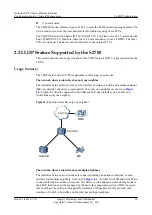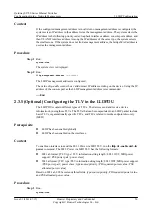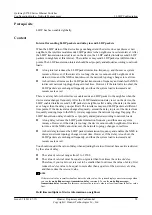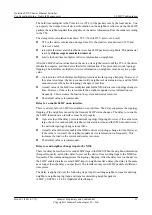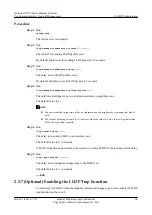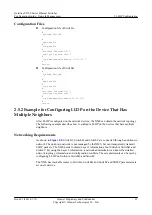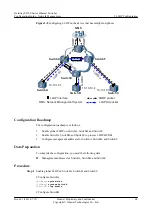
The hold time multiplier is the Time to Live (TTL) of the packets sent by the local device. You
can specify the storage time of device information on the neighbors. After receiving the LLDP
packets, the neighbors update the aging time of the device information from the sender according
to the TTL.
The storage time calculation formula is: TTL = Min (65535, (
interval
x
hold
)).
l
TTL is the device information storage time. It is the smaller value between 65535 and
(
interval
x
hold
).
l
interval
is the interval at which the device sends LLDP packets to neighbors. This parameter
is set by
lldp message-transmission interval
.
l
hold
is the hold time multiplier of device information on neighbors.
After the LLDP function is disabled on the device, its neighbors wait until the TTL of the device
information expires, and then delete the device information. This prevents network topology
flapping. The hold time multiplier of device information on neighbors must be set to a proper
value.
l
A great value of the hold time multiplier prevents network topology flapping. However, if
the value is too large, the device cannot notify neighbors of its status in time, and the NMS
cannot discover the network topology changes in real time.
l
A small value of the hold time multiplier enables the NMS to discover topology change in
time. However, if the value is too small, the neighbors update device information too
frequently. This increases the load on the system and wastes resources.
l
The default value is recommended.
Delay to re-enable LLDP on an interface
There is a delay before LLDP is re-enabled on an interface. The delay suppresses the topology
flapping of the neighbors caused by the frequent LLDP status changes. The delay to re-enable
the LLDP function on an interface must be set properly.
l
A great value of the delay prevents network topology flapping. However, if the value is too
large, the device cannot notify neighbors of its status in time, and the NMS cannot discover
the network topology changes in real time.
l
A small value of the delay enables the NMS to discover topology change in time. However,
if the value is too small, the neighbors update device information too frequently. This
increases the load on the system and wastes resources.
l
The default value is recommended.
Delay to send neighbor change traps to the NMS
There is a delay before the device sends LLDP traps to the NMS. When the neighbor information
changes frequently, extend the delay to prevent the device from sending traps to the NMS too
frequently. This command suppresses the topology flapping. After the delay is set on the device,
the LLDP enabled interfaces send LLDP traps to neighbors after a delay (the delay is the same
as or longer than the delay you specified). The interfaces may send LLDP packets at different
time points.
The delay is applied to only the following traps: traps for adding neighbors, traps for deleting
neighbors, neighbor aging traps, and traps for discarding neighbor packets
(LLDP_1.0.8802.1.1.2.0.0.1 lldpRemTablesChange).
Quidway S2700 Series Ethernet Switches
Configuration Guide - Network Management
2 LLDP Configuration
Issue 01 (2011-07-15)
Huawei Proprietary and Confidential
Copyright © Huawei Technologies Co., Ltd.
59






